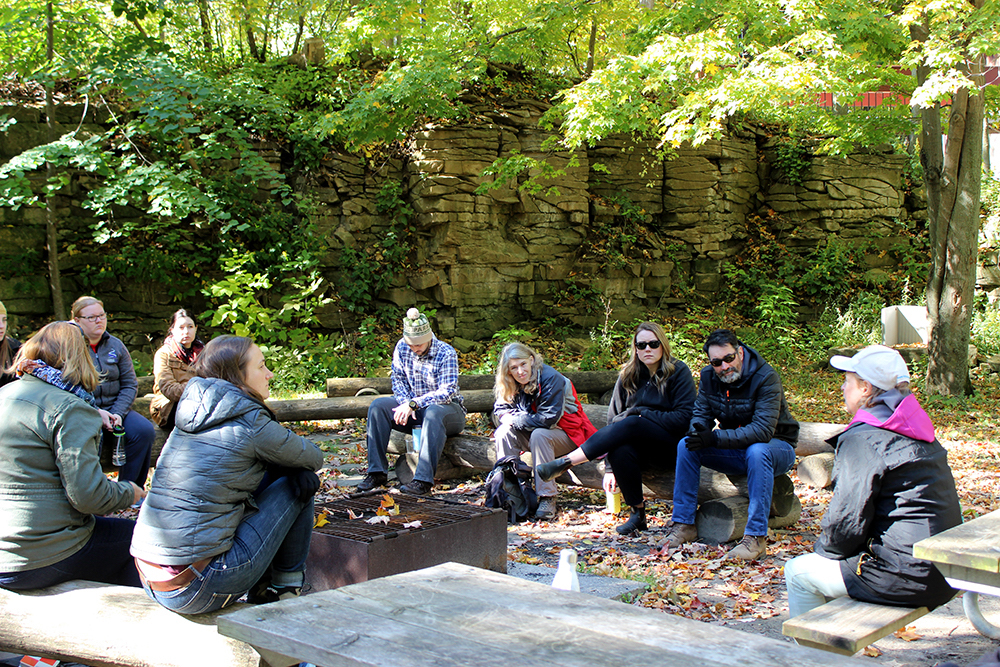THURSDAY, NOVEMBER 22, 2018 | by Jeannie Mackintosh
 Professor Liette Vasseur, far right, speaks to Master of Sustainability students in the core zone of the Niagara Escarpment Biosphere Reserve at Brock University.
Professor Liette Vasseur, far right, speaks to Master of Sustainability students in the core zone of the Niagara Escarpment Biosphere Reserve at Brock University.As a group of Brock students recently learned, sustainability science is all around us.
It can be found along the Niagara Escarpment, in the waste-sorting stations of Guernsey Market and on the properties of the Niagara Parks Commission.
Students in the Sustainability Science and Society graduate program got a taste of sustainability initiatives in action during a series of field trips in October.
The Master of Sustainability program has always encouraged students to think critically about the theories behind sustainability science. Developing a sound theoretical understanding is essential, but practical application also plays a major role, said Ryan Plummer, Director of the Environmental Sustainability Research Centre (ESRC) and Professor of Foundations of Sustainability Science and Society.
“We train students to be leaders in sustainability. They need more than just classroom instruction to prepare them to take on leadership positions when they graduate,” Plummer says.
A series of three field trips added an experiential education component to the program this year, giving students a first-hand look at how sustainability science is implemented on Brock’s main campus and in the wider Niagara community.
“Sustainability science extends beyond the classroom and the University campus,” says Plummer. “Modifying the curriculum in our foundational course to include an ‘experiencing sustainability’ module enables new ways to connect theory and practice.”
On the first trip, Liette Vasseur, Professor of Biology and Environmental Science and UNESCO Chair of Community Sustainability, led an outdoor education-based exploration of the Niagara Escarpment, a UNESCO Biosphere Reserve. Lisa Gribinicek, Senior Strategic Advisor with the Niagara Escarpment Commission, also spoke with students about the area.
The second trip focused on sustainability efforts at higher learning institutions and included a tour of Brock’s Central Utilities Building. Scott Johnstone, Associate Vice-President of Facilities Management, and Ryan Stewart, Energy Manager of Maintenance and Utilities Services, demonstrated how current University initiatives contribute to the Brock University Project Charter on environmental sustainability. Students learned how Brock is working towards its goals of low emissions and an overall sustainable campus.
At Guernsey Market, students visited the waste-sorting area to see what happens behind the scenes to the scraps and recyclable containers left behind after a cafeteria meal. Bryan Boles, Associate Vice-President of Ancillary Services, and Malcolm Dale, Associate Director of Operations, described the sustainability challenges faced in Dining Services.
The final trip focused on the ESRC’s innovative partnerships with the Town of Lincoln and the Niagara Parks Commission, and included a tour of the Vineland Research and Innovation Centre.
“Seeing how the world works outside of the classroom is an invaluable experience,” says Meredith DeCock, a candidate in the Master of Sustainability program.
Each field trip in the series was “unique and engaging” according to DeCock. “I even presented my research to the Town of Lincoln,” she says.
Readings and assignments took precedence but, beyond the serious work of learning, there was also time for some fun. In Niagara Falls, students enjoyed the famed Journey Behind the Falls.
“When an experiential learning session includes a trip to Niagara Falls, you really can’t go wrong,” says DeCock.
“The thoughtful development and execution of the field study modules is a perfect example of why Brock is such a leader in experiential education,” says Carolyn Finlayson, Experiential Education Co-ordinator for the Faculty of Social Sciences. “Bringing to life course theories and concepts outside the classroom is what we do best.”
The trips were organized with financial support from a Teaching Learning and Innovation grant.
Story originally published in The Brock News.











